Improved Thermal Switch Based on an Adsorption Material in a Heat Pipe
Abstract
:1. Introduction
- Numerical model and insulation: In this work, a numerical model is presented and validated to take into account the effects of insulation and parasitic heat currents on the environment. These effects are shown to have a large impact on the obtained switching ratio;
- Wetting behavior: The wetting behavior of the working fluid in the pipe-based heat switch plays an important role and is characterized using an array of thermocouples arranged along the longitudinal axis of the demonstrator and the model mentioned above;
- Adsorbent position vs. heat source size and position: The adsorbent position relative to heat source size and position is examined and optimized. Moreover, a special double heater configuration with variable heat power ratios is used in one of the demonstrators;
- Switching factor: Applying improvements 1 to 3 is shown to enable a greatly improved switching ratio of up to 36;
- Proper amount of sorbent: In this work, two amounts of sorbent are tested and both proven to be suitable for operation (with a slight difference in transition sharpness between conducting and non-conducting states);
- Hysteretic behavior: It is examined if the heat switch exhibits hysteretic behavior, i.e., a thermal resistance that is significantly different when ramping up and ramping down heat powers or, in the worst case, might perhaps not switch off again when heat powers are reduced, and sorbent temperatures fall below . This would be a disadvantage for many practical applications;
- Container material: In this work, a simple heat pipe made of copper with a cylindrical shape and a diameter of 10 mm is used. This represents a non-fragile, bendable and inexpensive container body for a heat switch.
2. Materials and Methods
2.1. Basic Idea and Preparation of Sorbent Material
2.2. Demonstrator
2.3. Determination of Measured Thermal Resistance
2.4. Calculation of Ideal Thermal Resistance without Parasitic Thermal Losses
- as parasitic radial heat flux from the heat switch through the insulation to the environment at coordinate x;
- as parasitic heat flux from the bottom of the evaporator to the environment;
- as heat flux input by the heaters at coordinate x in evaporator zone;
- as total axial heat flux along the thermal switch;
- as total length of the evaporator, i.e., heater;
- as length of the adiabatic zone;
- as length of the condenser with attached cooler;
- as cooler and condenser temperature;
- as ambient room temperature;
- as radius of the insulated heat pipe;
- as heat transfer coefficient of natural convection;
- as outer radius of the heat pipe without insulation;
- as thermal conductivity of the insulation (obtained indirectly by fit, see Appendix A.1).
- 8.
- Apply a certain heat power and measure the temperatures along the thermal switch at the locations given in Table 1.
- 9.
- From the measured temperatures, obtain a continuous temperature distribution by a modified Akima spline interpolation [13] (also called “Makima splines”) using MATLAB.
- 10.
- Discretize to obtain discrete values for .
- 11.
- Insert for in Equation (7) to obtain and calculate from Equation (6).
- 12.
- Insert and into Equation (5) and discretize the obtained axial heat flux to obtain discrete values for .
- 13.
- Input the obtained and into Equation (11) and add up all discrete thermal resistances to yield the total thermal resistance .
3. Results and Discussion
3.1. General Experimental Procedure
3.2. Results for Demonstrator Siphon-1
3.3. Results for Demonstrator Siphon-2
3.4. Outlook: Improvements of Thermal Switch
4. Conclusions
- The basic working principle of a sorbent-based heat switch can be adapted to a heat pipe (thermosyphon) made of copper with outer diameters that are common in heat pipe applications (in this work, 10 mm);
- 4 g or 6 g of sorbent loaded with 24.1% of water is a suitable amount for the operation of the heat switch;
- The switching effect is reversible. The heat switch switches from the off- to the on-state if heat powers are ramped up and switches back from the on- to the off-state if heat powers are ramped down afterward;
- A comparison between thermal resistances for different insulations is made, i.e., between (i) , obtained from actual measurements and (ii) , obtained from a numerical model that “simulates” a perfect thermal insulation of the heat switch against parasitic heat fluxes into the environment. A large difference between these thermal resistances became evident, particularly in the off-state of the heat switch. This leads to a strong dependence of the obtained thermal switching ratios on the insulation of the heat switch. For a better insulation, higher can be expected;
- For an efficient operation of the heat switch with high , it is very important to input the heat primarily above the sorbent column rather than directly at the sorbent column. This was concluded from experiments with different heater lengths and centers of heat inputs that were varied using a stacked two-heater configuration and different ratios of heat powers for the top and bottom heater. Inputting heat directly at the sorbent column led to a dryout of the evaporator, high thermal resistance in the on-state and, consequently, a low switching ratio. If the heat was input mainly by the top heater, i.e., above the sorbent column, the switching ratio could be increased to up to 36 for and 10 for . This is a clear improvement from the switching ratios obtained in our previous work.
- Optimizing the heater should lead to a lower thermal resistance in the on-state, and choosing a heat pipe container material with lower thermal conductivity should lead to a higher thermal resistance in the off-state. Thus, the switching ratio can be increased;
- Gravity-independent operation can be realized by using a heat pipe with an integrated wick structure;
- Optionally, an active thermal switch can be realized by providing a dedicated “sorbent heater” and then thermally separating the sorbent column plus sorbent heater from the rest of the system.
5. Patents
Author Contributions
Funding
Institutional Review Board Statement
Informed Consent Statement
Data Availability Statement
Conflicts of Interest
Appendix A
Appendix A.1. Obtaining the Necessary Thermal Resistances for Calculating
| Thermal Resistance | Value Obtained by Fit | Expected Values |
|---|---|---|
| 84.7 K/W | 84.9 K/W 1 | |
| 10.6 K/W | 10.9 2–13.1 3 K/W 4 | |
| 88.4 K/W | - |
Appendix A.2. Determination of Measurement Uncertainty for , and
| Property | Symbol | Value of Uncertainty |
|---|---|---|
| Temperatures measured by thermocouples | 0.33 K (Siphon-1, type K) 1 0.11 K (Siphon-2, type T) 1 | |
| Thermocouple positions | 3 mm | |
| Electrical resistance of heater wire | 0.01 Ohms | |
| Heater voltages | 0.2% |
Appendix A.2.1. Measurement Uncertainty on
Appendix A.2.2. Measurement Uncertainty on
- A random parameter distribution is generated for the parameters given in Table A2 with a variation width corresponding to the uncertainties as given in the table. It is assumed that the given uncertainties are uncorrelated and normally distributed.
- A fit according to Equation (A8) is carried out to data resulting from each parameter distribution, yielding different values for , , for each distribution.
- For the parameters that change between measurements in Table A2, a new random distribution is generated.
- Using all generated parameters, is determined according to Equation (11) and the model procedure given in Section 2.4.
Appendix A.2.3. Measurement Uncertainty on
Appendix A.3. Note on Switching Temperature as Described in Section 2.1
References
- Blumenthal, P.; Raatz, A. Classification of electrocaloric cooling device types. EPL 2016, 115, 17004. [Google Scholar] [CrossRef]
- Wehmeyer, G.; Yabuki, T.; Monachon, C.; Wu, J.; Dames, C. Thermal diodes, regulators, and switches: Physical mechanisms and potential applications. Appl. Phys. Rev. 2017, 4, 41304. [Google Scholar] [CrossRef] [Green Version]
- Reay, D.A.; Kew, P.A.; McGlen, R.J. Heat Pipes: Theory, Design and Applications, 6th ed.; Butterworth-Heineman: Oxford, UK, 2013. [Google Scholar]
- Groll, M.; Munzel, W.D.; Supper, W.; Savage, C.J. Development of a Liquid-Trap Heat Pipe Thermal Diode. J. Spacecr. Rocket. 1979, 16, 195–202. [Google Scholar] [CrossRef]
- Boreyko, J.B.; Zhao, Y.; Chen, C.-H. Planar jumping-drop thermal diodes. Appl. Phys. Lett. 2011, 99, 234105. [Google Scholar] [CrossRef] [Green Version]
- Tsukamoto, T.; Hirayanagi, T.; Tanaka, S. Micro thermal diode with glass thermal insulation structure embedded in a vapor chamber. J. Micromech. Microeng. 2017, 27, 45001. [Google Scholar] [CrossRef]
- Benafan, O.; Notardonato, W.U.; Meneghelli, B.J.; Vaidyanathan, R. Design and development of a shape memory alloy activated heat pipe-based thermal switch. Smart Mater. Struct. 2013, 22, 105017. [Google Scholar] [CrossRef]
- Leriche, M.; Harmand, S.; Lippert, M.; Desmet, B. An experimental and analytical study of a variable conductance heat pipe: Application to vehicle thermal management. Appl. Therm. Eng. 2012, 38, 48–57. [Google Scholar] [CrossRef]
- Winkler, M.; Teicht, C.; Corhan, P.; Polyzoidis, A.; Bartholomé, K.; Schäfer-Welsen, O.; Pappert, S. Thermal Switch Based on an Adsorption Material in a Heat Pipe. Energies 2021, 14, 5130. [Google Scholar] [CrossRef]
- Thommes, M.; Kaneko, K.; Neimark, A.V.; Olivier, J.P.; Rodriguez-Reinoso, F.; Rouquerol, J.; Sing, K.S.W. Physisorption of gases, with special reference to the evaluation of surface area and pore size distribution (IUPAC Technical Report). Pure Appl. Chem. 2015, 87, 1051–1069. [Google Scholar] [CrossRef] [Green Version]
- Greenspan, L. Humidity fixed points of binary saturated aqueous solutions. J. Res. Natl. Bur. Stan. Sect. A 1977, 81A, 89. [Google Scholar] [CrossRef]
- Armacell Enterprise GmbH & Co. KG. Technical Data-HT/Armaflex. Available online: https://local.armacell.com/en/armacell-germany/products/htarmaflex/ (accessed on 8 February 2022).
- Akima, H. A new method of interpolation and smooth curve fitting based on local procedures. J. ACM 1970, 17, 589–602. [Google Scholar] [CrossRef]
- Deutsches Kupferinstitut Berufsverband e.V. Werkstoff-Datenblatt Cu-DHP. Available online: https://www.kupferinstitut.de/mediathek/datenblaetter/ (accessed on 7 February 2022).
- Schipper, J. Charakterisierung und Modellierung Passiver Heatpipe-Basierter Wärmeschalter. Master’s Thesis, Technische Universität Braunschweig, Institut für Thermodynamik, Braunschweig, Germany, 2022. [Google Scholar]

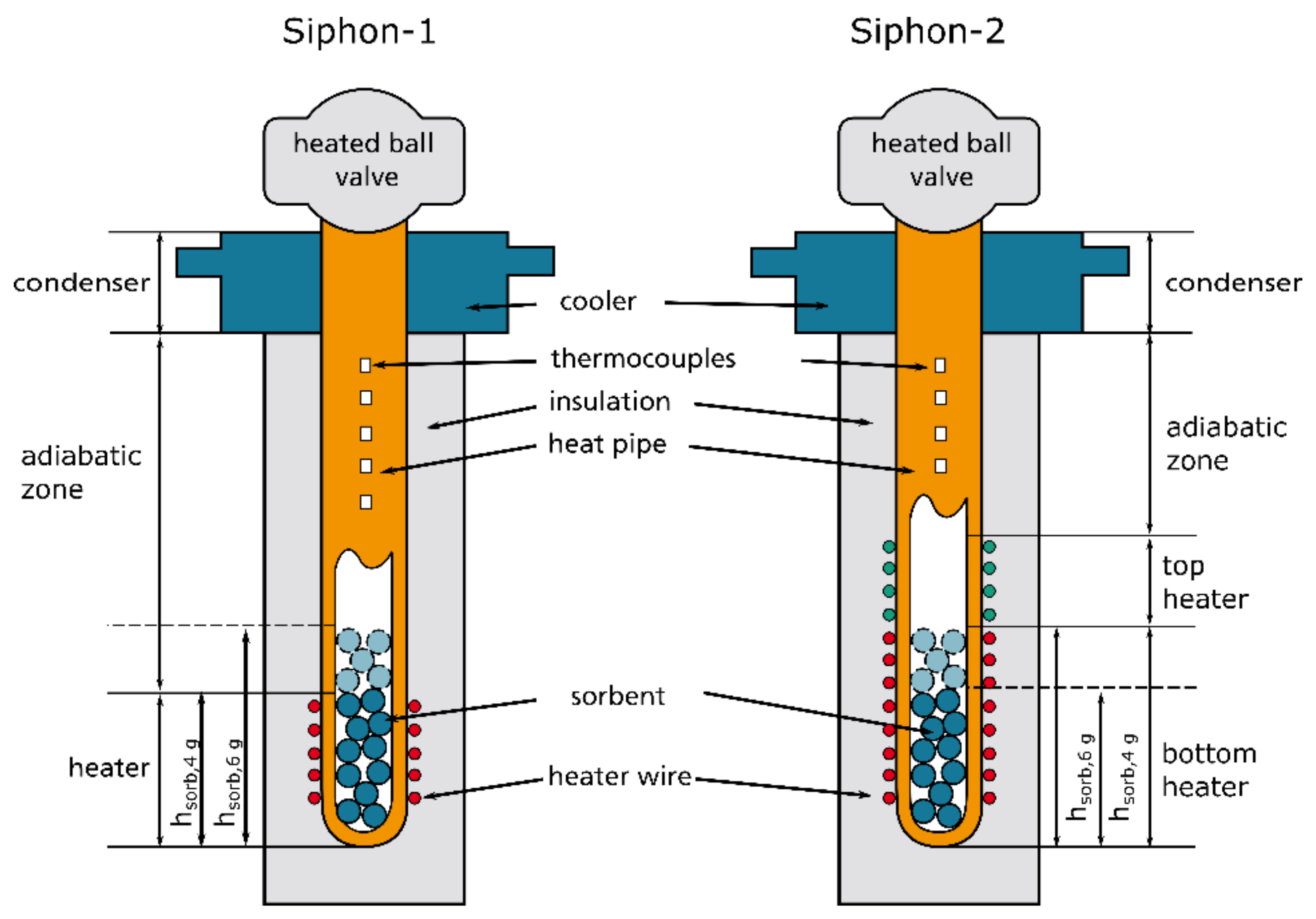

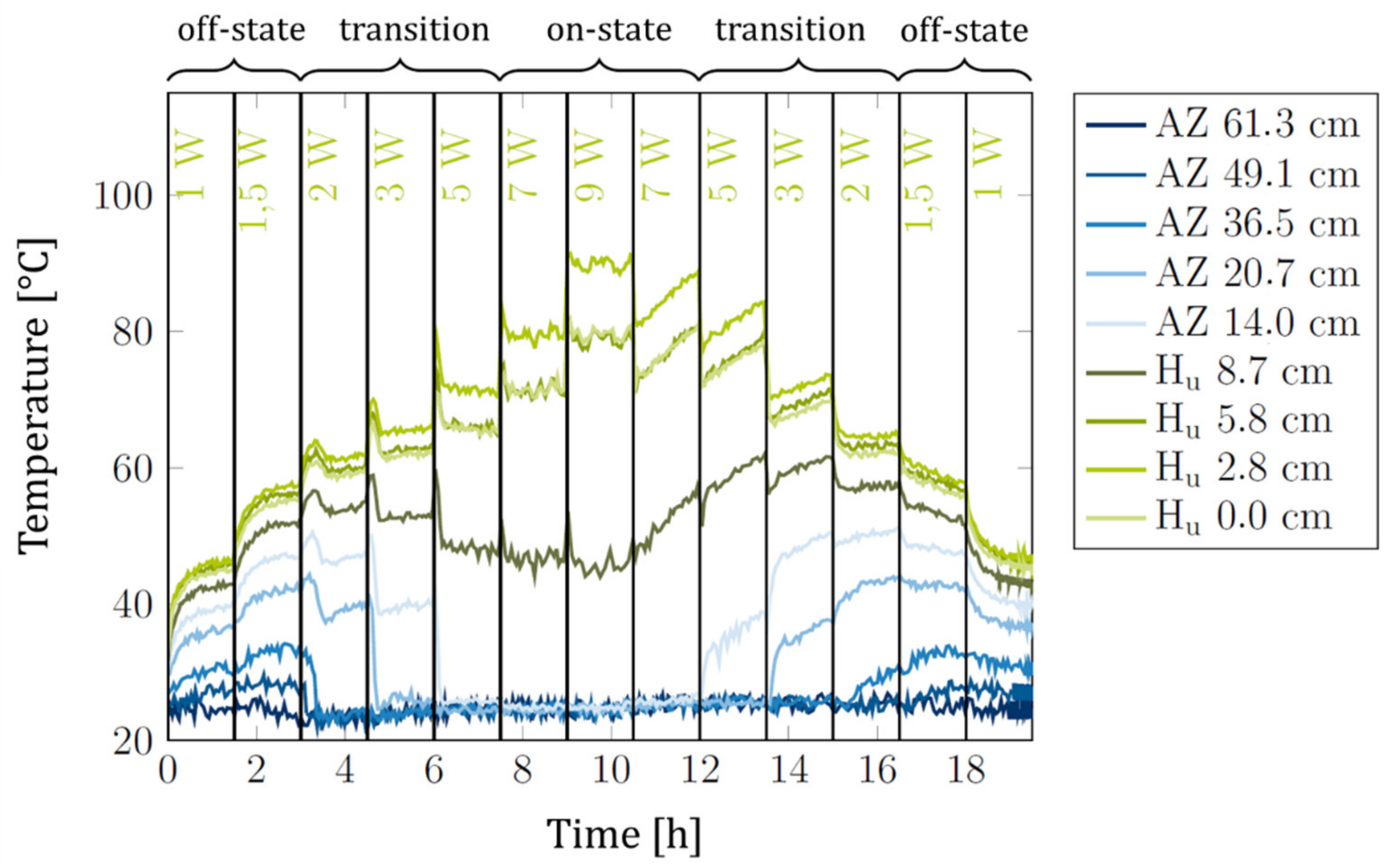

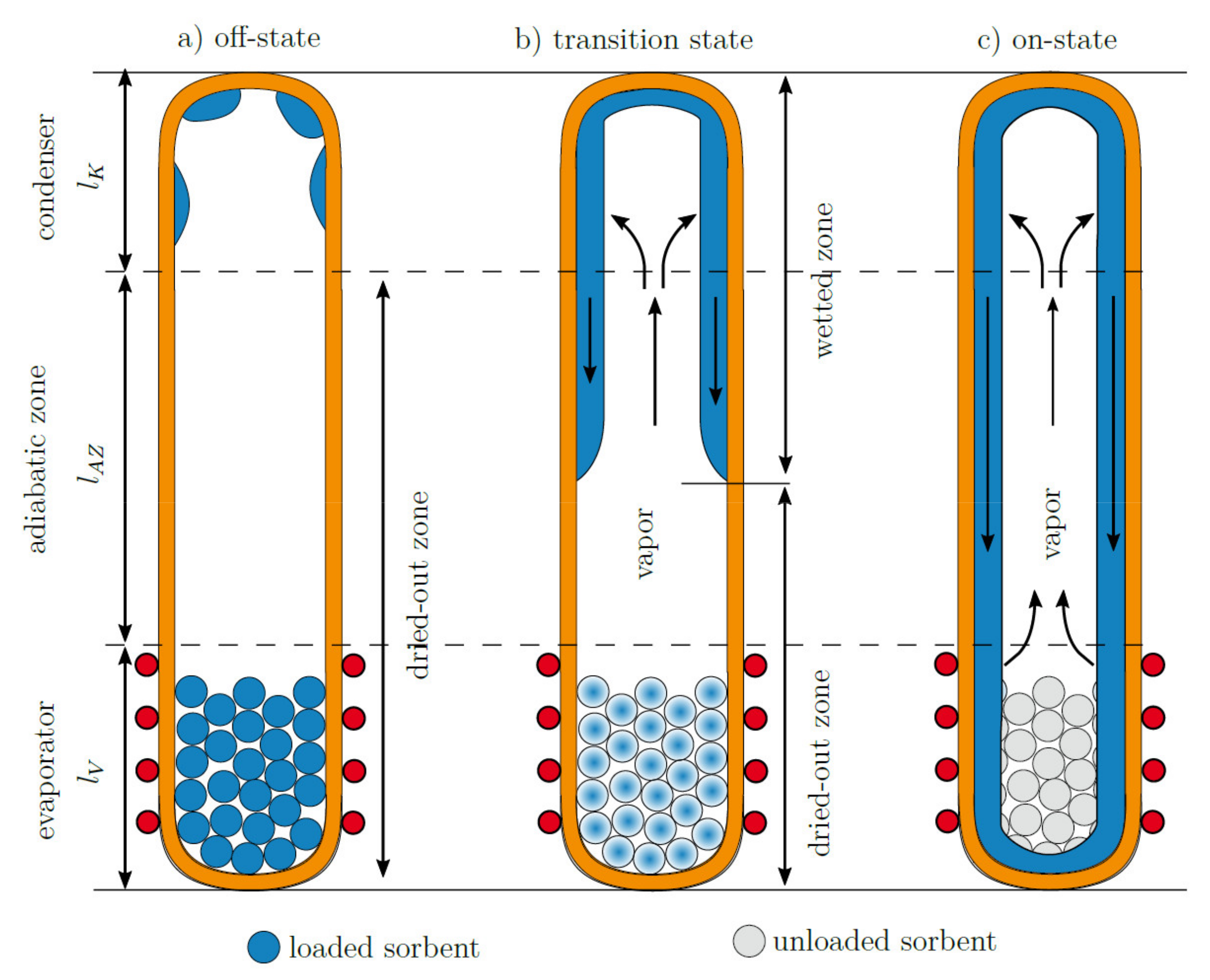
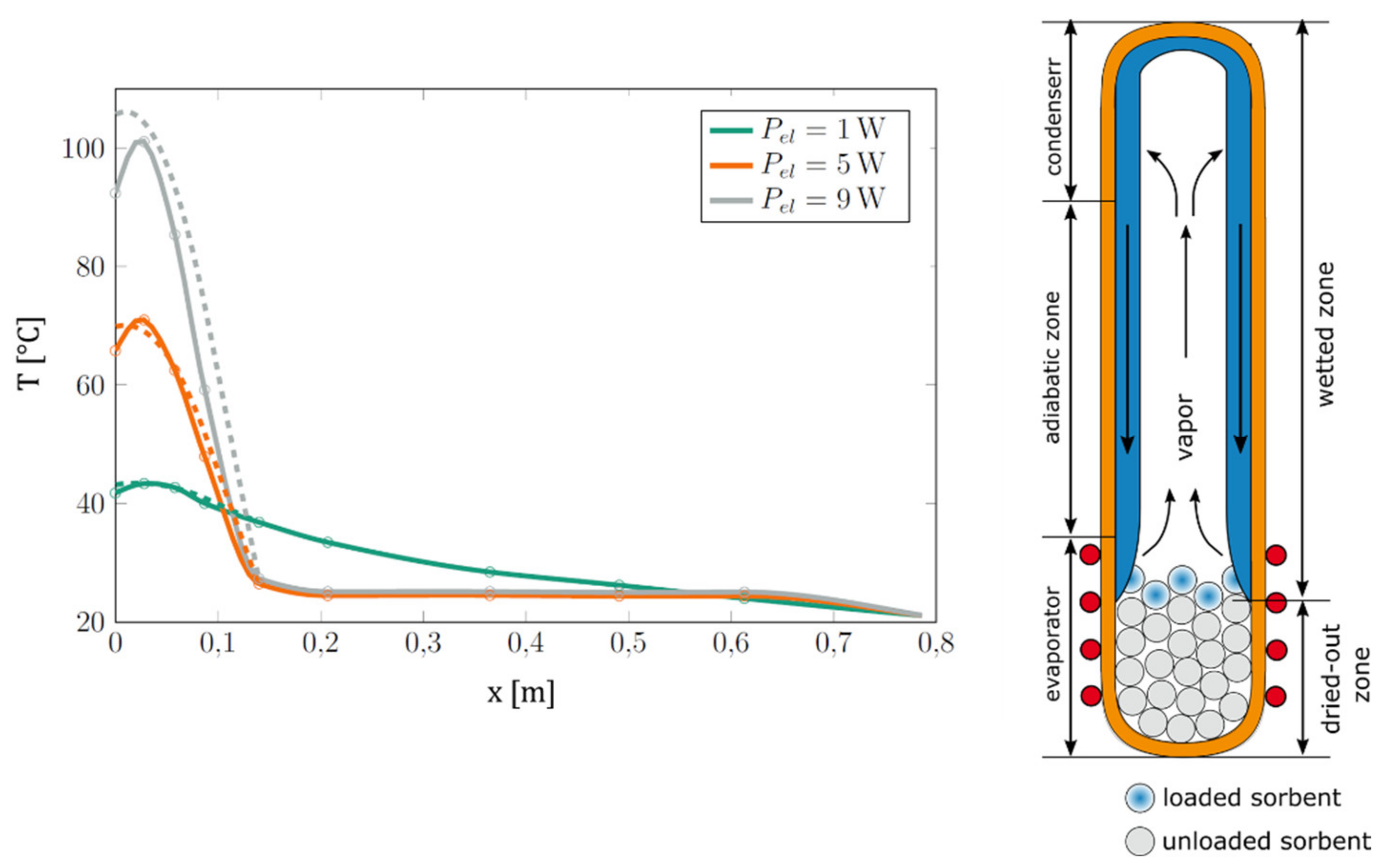
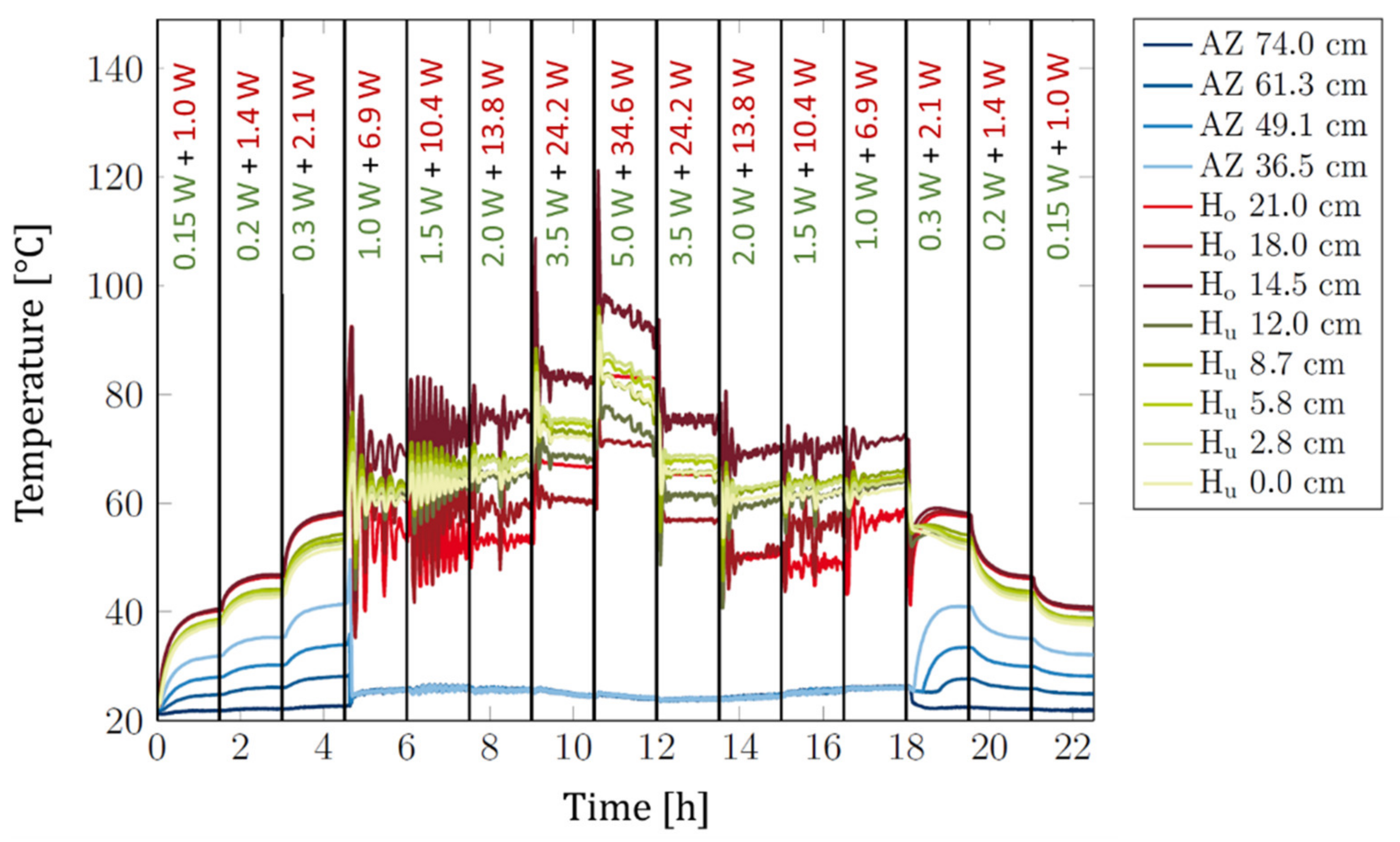
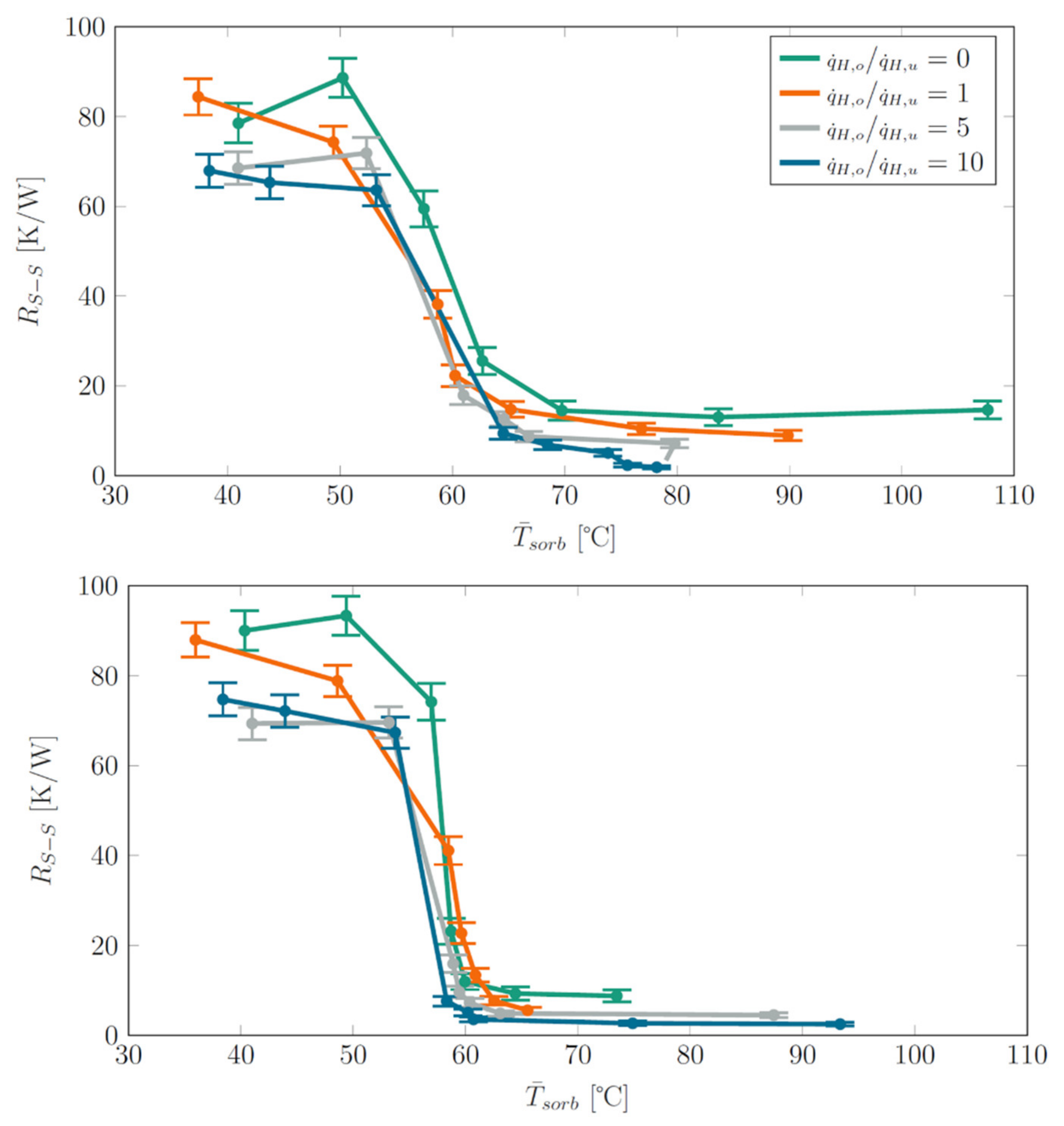
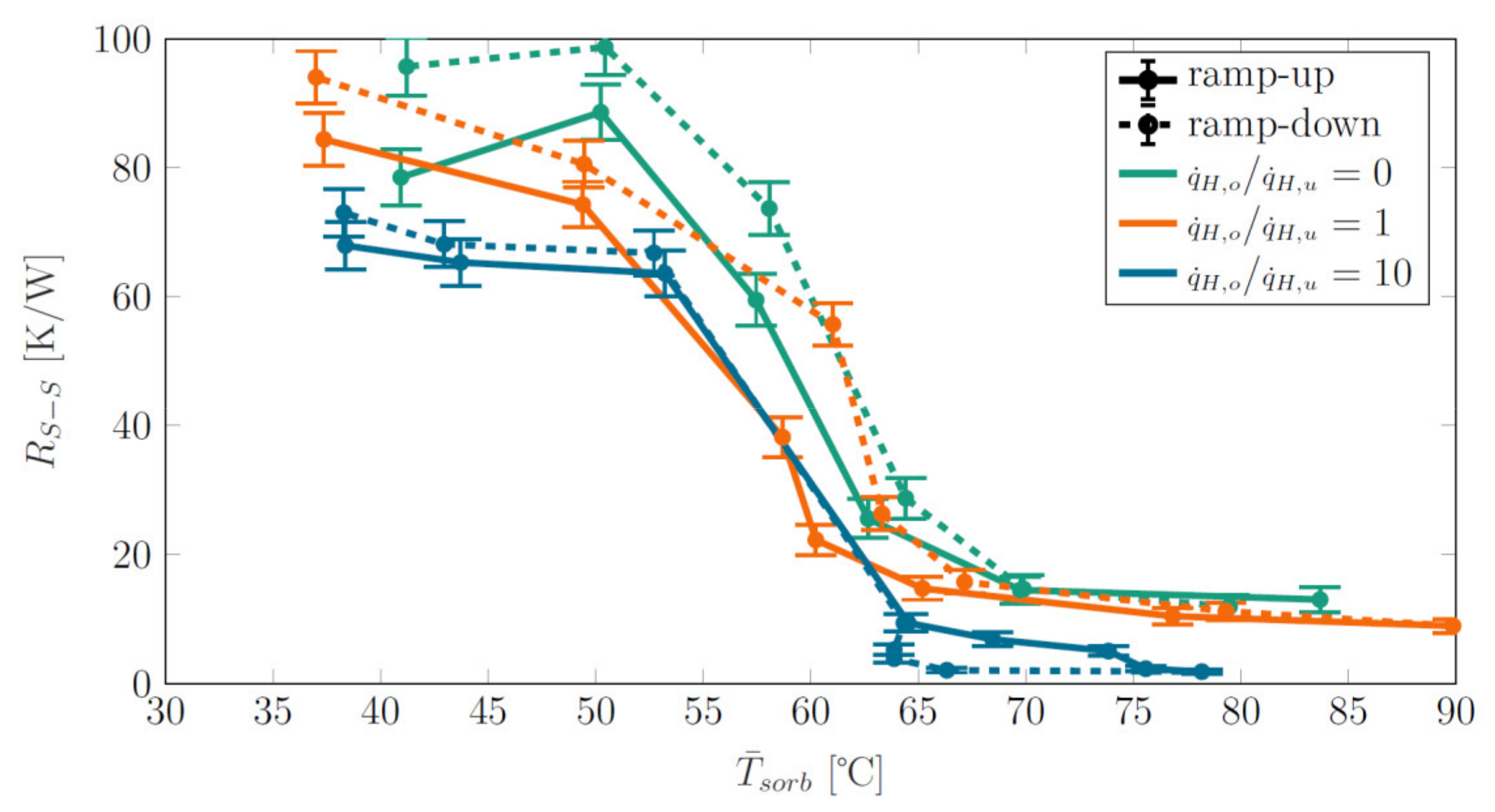

| Name | Variable | Siphon-1 | Siphon-2 |
|---|---|---|---|
| Used data logger | Graphtec GL240 | Graphtec GL840 WV | |
| Thermocouple type | Type K ∅ 0.08 mm | Type T ∅ 0.08 mm | |
| Thermocouple position [cm] | 0, 2.8, 5.8, 8.7, 14, 20.7, 36.5, 41.9, 61.3 | 0, 2.8, 5.8, 8.7, 12.0, 14.5, 18.0, 21.0, 36.5, 49.1, 61.3, 74 | |
| Outer radius of heat pipe | 5 mm | ||
| Outer radius of heat pipe with insulation | 42.5 mm | ||
| Inner radius of heat pipe | 4 mm | ||
| Length of condenser | 12 cm | ||
| Length of adiabatic zone | 70 cm | 57 cm | |
| Length of bottom heater | 9 cm | 13 cm | |
| Length of top heater | - | 9 cm | |
| Sorbent filling weight | 4 g, 5 g, 6 g | ||
| Resulting filling height of sorbent column | 8.6 cm, 10.7 cm, 12.9 cm | ||
| Off-State | On-State | ||
|---|---|---|---|
| 95 ± 11 K/W | 10 ± 3 K/W | 10 ± 3 | |
| 25 ± 0.2 K/W | 7 ± 0.05 K/W | 3.6 ± 0.05 |
Publisher’s Note: MDPI stays neutral with regard to jurisdictional claims in published maps and institutional affiliations. |
© 2022 by the authors. Licensee MDPI, Basel, Switzerland. This article is an open access article distributed under the terms and conditions of the Creative Commons Attribution (CC BY) license (https://creativecommons.org/licenses/by/4.0/).
Share and Cite
Winkler, M.; Schipper, J.; Teicht, C.; Corhan, P.; Polyzoidis, A.; Bartholomé, K.; Schäfer-Welsen, O.; Pappert, S. Improved Thermal Switch Based on an Adsorption Material in a Heat Pipe. Energies 2022, 15, 3271. https://doi.org/10.3390/en15093271
Winkler M, Schipper J, Teicht C, Corhan P, Polyzoidis A, Bartholomé K, Schäfer-Welsen O, Pappert S. Improved Thermal Switch Based on an Adsorption Material in a Heat Pipe. Energies. 2022; 15(9):3271. https://doi.org/10.3390/en15093271
Chicago/Turabian StyleWinkler, Markus, Jan Schipper, Christian Teicht, Patrick Corhan, Angelos Polyzoidis, Kilian Bartholomé, Olaf Schäfer-Welsen, and Sandra Pappert. 2022. "Improved Thermal Switch Based on an Adsorption Material in a Heat Pipe" Energies 15, no. 9: 3271. https://doi.org/10.3390/en15093271
APA StyleWinkler, M., Schipper, J., Teicht, C., Corhan, P., Polyzoidis, A., Bartholomé, K., Schäfer-Welsen, O., & Pappert, S. (2022). Improved Thermal Switch Based on an Adsorption Material in a Heat Pipe. Energies, 15(9), 3271. https://doi.org/10.3390/en15093271






